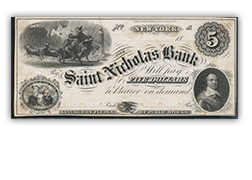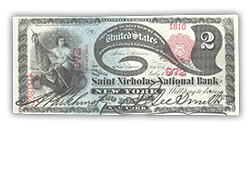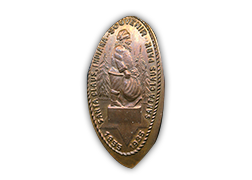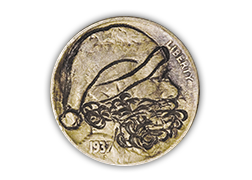Holiday Double Feature: The Christmas Truce & St. Nicholas Bank Notes
The Christmas Truce
As Christmas 1914 approached, it was becoming clear to many soldiers that the war was not going to end soon. Front line troops were increasingly disillusioned with the horror and pointlessness of the fighting and were homesick — they had been promised a short war. American newspapers, taking a neutral stance, suggested that the combatants should observe a “Christmas truce” that might allow them to stand back and think about whether the war was worth the cost. No official truce was called, but an unofficial truce did occur along parts of the Western Front between German and British units and soldiers fraternized, sang songs, exchanged gifts and food, and even competed in soccer games. Senior officers on both sides soon put an end to the demonstrations of comradeship and goodwill to ensure that the business of war could go on …
Bavarian medalist Karl Goetz issued a series of annual medals from 1914 to 1918 commemorating the sacrifice of soldiers and celebrating Christmas. On each medal, a German military and political leader appears on the obverse, while the reverses depict one, two, three, four or five candles, symbolizing the year of the war. The first four medals have a legend translating to “Christmas on the field,” while the 1918 medal’s legend translates to “Christmas at home.” Each medal is 22.5 mm in diameter.
Explore the Money Museum's virtual exhibit below. View on desktop for full experience.
 |
|
Click on the items in the case image below for an enhanced view.

St. Nicholas Bank Notes
As busy as he is during the holiday season, how did Santa Claus ever find time to pose for a series of bank notes in 19th century America?
December 6 is the Feast of Saint Nicholas, a day children awaken to find gifts left in their shoes. The historical Saint Nicholas (AD 270-343) was the patron saint of archers, sailors, brewers, children and students. He also earned a reputation for secretly giving gifts, serving as the model for everyone’s favorite Christmas gift distributor – Santa Claus, sometimes referred to as jolly St. Nick.
In the mid-1800s, the Saint Nicholas Bank in New York City released its own paper money bearing engraved images of Santa Claus delivering toys and sweets to good girls and boys. The bank opened in 1853 and issued the whimsical notes made by private printers in several denominations, including $3 bills. Like most obsolete currency, Saint Nicholas Bank notes are printed on one side only. Today, they're highly sought as collectibles by paper money enthusiasts and Santa devotees.
"Yes, Virginia, there once was a Saint Nicholas Bank $2 note."
Obsolete bank notes were produced between 1792 and 1866 before the U.S. federal government issued its own paper money in the 1860s during the Civil War. They were issued by private banks and businesses that successfully applied for a state charter. Including the Saint Nicholas Bank, 21 banks from 8 states (27 total notes) issued obsolete notes featuring Santa Claus. Seven total Santa vignettes were used (there are no examples of type VII; it is lost to history).
Santa Claus has also appeared on other genres of numismatics, including checks, stock certificates, scrip, gift cards, tokens, medals, wishing coins, elongates and altered currency. Notgeld (emergency hyperinflation money) featuring Kris Kringle was issued in Germany and Austria during and after World War I.
Explore the Money Museum's online exhibit below. View on desktop for full experience.
Click on the objects below for an enhanced view.
About the American Numismatic Association
The American Numismatic Association is a nonprofit organization dedicated to educating and encouraging people to study and collect coins and related items. The Association serves the academic community, collectors and the general public with an interest in numismatics.
The ANA helps all people discover and explore the world of money through its vast array of educational programs including its museum, library, publications, conventions and numismatic seminars.

.jpg)













